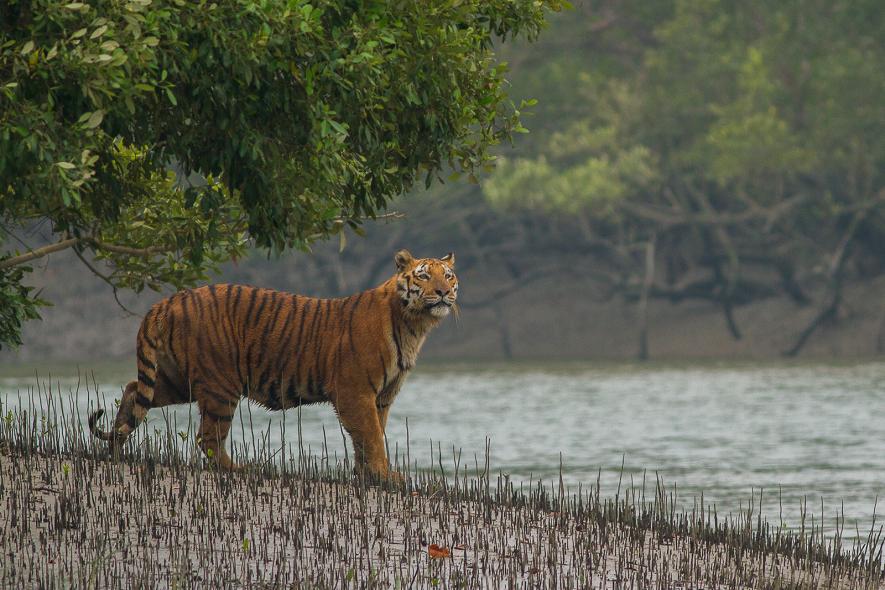Poverty-Stricken Fishers Suffering Repeated Tiger Attacks in Sundarbans

Kolkata: It was only last week that Chittaranjan Sarkar, 45, had gone fishing for crabs in the core area of Sundarban tiger reserve. Suddenly a tiger leapt on him and carried him away before his friends could raise the alarm. The incident happened last Tuesday in the Basirhat forest range. Sarkar was a resident of Lahirpur village in Gosaba block.
The rate of tiger attacks has risen manifolds in West Bengal. The loss of tiger habitat is attributed as the main reason for the renewed man-animal conflict in the Sundarban regions of the state.
In the past fortnight, more than five people have lost their lives in tiger attacks. Last Monday, in the Benifili forest area, Sankar Sardar, a fisherman, was injured in a tiger attack. He, however, later succumbed to his injuries in a Kolkata hospital. Another fisherman, Arabinda Biswas, who had gone to catch crabs with two of his associates in the Jhila forest area, lost his life last Sunday. Sardar was a resident of Kumirmari area of Sundarbans.
The list of dead is, in fact, enormous, according to Kanti Ganguly, former Sundarban development minister, government of West Bengal, and a veteran politician of the marshy region. He claimed that some 43 crab catchers had fallen prey to tiger attacks in the last seven months in Sundarbans. On why these pisciculturists were venturing into the core area of the Sundarban tiger reserve, Ganguly believed that hunger was the leading cause that motivated poverty-stricken fishermen to catch crabs and prawns and sell them in nearby markets of Kolkata for Rs 500 per kg.
Indeed, the state of poverty is such that about 80% to 90% of male villagers from the Sundarbans now either reside outside the state in Tamil Nadu, Andhra Pradesh and Kerala, working as daily wagers for reaping paddy. Cyclone Amphan that hit last year made farming impossible in Sundarbans due to saline water's inundation of paddy fields.
The rest of the energetic youth who remain here venture out to catch crabs and prawns and sell them in the local haats (markets) in the afternoon hours to make a living.
The archipelago, situated in the southernmost part of the Gangetic basin, extends between two rivers— Hooghly in the west, in West Bengal, India, and Meghna in the east, in Bangladesh. The Sundarbans in India spans two districts in West Bengal—North and South 24 Parganas —covering 19 blocks and 9,630 sq km, of which almost half is forested. There are 102 islands in the Indian Sundarbans, of which 54 are inhabited, and the rest are notified as reserve forests.
Talking with NewsClick, Saraj Tarafdar, a village homoeopathic doctor by profession in Satajelia village, said that the economic condition of the people of Sundarbans had deteriorated over the years and added that “The lockdown made them interned in their own house without any food or rations. Given this, fishermen from Satajelia, Lahiripur regularly venture out to the Sundarban islands to catch crabs mainly in the Chilapata forest area.”
Tarafdar added that he had come across a case of a tiger attack in the Kultali police station area last month. “On one side, the Modi government has stopped the free rationing systems of rice and cereals in the state, and on the other side, the State government has withheld the ration cards of residents of Sundarbans, as many of them have migrated out. It is impossible for the womenfolk to regularly visit ration shops located in different islands. Apart from that, the local TMC MLA has illegally acquired land in Bali dwip (riverine island) on behalf of tourism. In Gosaba’s Hamilton Gunj area, even residents who inhabited the area for more than 75 years have been told to clear off the lands, where spots have been earmarked for tourism projects.”
He also claimed that most of the dead in the tiger attacks do not get any government compensation, and after the death of the only earning member, families become destitute.
Biswambhar Basu of MR Dealers’ Association affirmed Tarafdar, claiming that ration distribution was closed in the month of January. In February, it is expected that ration will be given, but from March there will be a halt in this service.
Talking with NewsClick, P Ulaganathan (IAS), the South 24 district magistrate, claimed that the government had done enough for the people of Sundarbans. “They are provided with rations and schemes like Laxmi Bhandar (where a sum of Rs 500 is deposited monthly in the account of the female member of the household),” admitting, however, that “Hurricanes like Amphan have robbed the people of Sundarbans of their living as farmers.” Nonetheless, he asserted that the administration was trying to do its best.
Ulaganathan went on, “The forest department has started fencing in tiger attack prone areas and islands, and the villagers are repeatedly urged not to go to the core areas for any activity. Surveillance and monitoring have also started to locate the tigers active in the area.”
He admitted that only in cases of tiger attacks in non-core areas was the compensation of Rs 2 lakh given. He only responded that the government had " done enough about the special drives of NREGA projects being executed in the area; he only responded that the government had “done enough.”
Get the latest reports & analysis with people's perspective on Protests, movements & deep analytical videos, discussions of the current affairs in your Telegram app. Subscribe to NewsClick's Telegram channel & get Real-Time updates on stories, as they get published on our website.
























